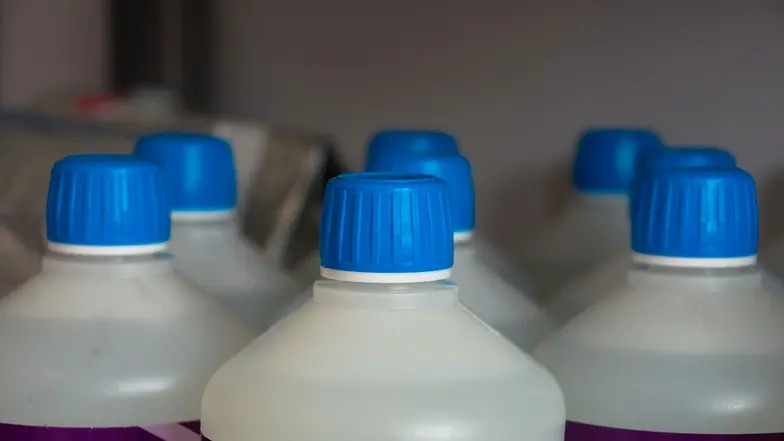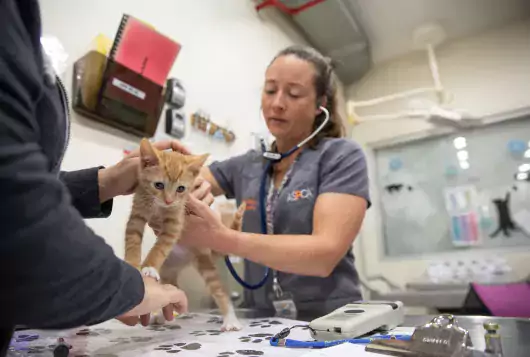Ingredients & Toxicities of Cleaning Products

Household items such as cleaning products are a staple on top 10 toxins lists every year for the ASPCA Animal Poison Control Center.
This article decodes common ingredients in cleaners to help you better understand the potential toxic risk for pets and your treatment options.
Acids and Bases
Acids will cause gastrointestinal irritation (vomiting, diarrhea, abdominal pain) with ingestion. But if a highly concentrated product or one with a very low pH is ingested, then burns to the mouth, esophagus and stomach may be possible.
Unlike bases, acids will cause immediate pain upon contact, which typically helps limit exposure. Acids are commonly found in toilet bowl cleaners, metal cleaners and pool sanitizers.
Bases, or alkalis, will cause gastrointestinal irritation as well. Like acids, they can cause corrosive injury with ingestion of highly concentrated product or products with a very high pH (>10). Bases are commonly found in oven cleaners, drain openers and automatic dishwasher soaps.
Bleach
There are two different types of bleaches: chlorine and non-chlorine (color safe). Chlorine bleach is also known as sodium hypochlorite. Most household bleaches contain 3-5% hypochlorite and when ingested primarily cause irritation to mucosal membranes leading to possible vomiting, diarrhea and nausea.
If a large amount of household bleach—or any amount of a concentrated hypochlorite (like a swimming pool disinfectant)—is ingested, burns of the mouth, esophagus and stomach are possible. Esophageal stricture is a rare sequela of a more serious ingestion.
Non-chlorine bleach typically contains hydrogen peroxide or percarbonates. In most household products the hydrogen peroxide content is low, around 3-5%. At this concentration ingested hydrogen peroxide may cause vomiting, mild gastrointestinal irritation, and on rare occasion gastrointestinal erosions.
With ingestion of more concentrated hydrogen peroxide (10% and higher) more serious effects may be seen: hemorrhagic gastritis, burns to the mouth, esophagus, stomach and possible gas embolization.
Percaronates, such as sodium carbonate, are alkaline corrosives that will result in ulcerations to the mouth, esophagus and stomach when ingested. While not common, esophageal strictures are possible sequela.
Enzymes
Enzymes are natural catalysts that help control the rate at which chemical reactions occur. They are most often found in laundry detergents and automatic dishwashing products. In household cleaners there may be several different kinds of enzymes found such as proteases, amylases and lipases. Generally enzymes have a wide margin of safety, so significant effects are typically not expected.
Surfactants
Surfactants are molecules that help reduce the tension of water, helping it to penetrate and loosen soil. Most commercially produced cleaning products contain surfactants. There are three different categories of surfactants: anionic, nonionic and cationic.
Ingestion of anionic and nonionic surfactants most commonly result in mild and self-limiting gastrointestinal upset. They can cause irritation to the skin and eye; rarely aspiration or caustic injury to the gastrointestinal tract may occur.
Examples of anionic detergents include alkylbenzene sulfonates, alkyl aryl sulfonate and dialkyl sulfosuccinate. Examples of nonionic surfactants include ethoxylated alcohols, PEG stearates, and alkyl aryl polyether sulfates.
Ingestion of cationic surfactants can be more serious, particularly in cats who appear to be sensitive to these surfactants. Cationic surfactants are irritating to mucosa, leading to gastrointestinal upset, but are more likely to cause burns of the mouth, esophagus and stomach than anionic or nonionic surfactants.
Hemorrhagic gastritis, aspiration, CNS depression and acute lung injury are possible with more serious exposure; dermal burns may occur with dermal exposure of concentrated products.
Examples of cationic surfactants include benzalkonium chloride and cetrimonium bromide. In addition to fabric softeners, they can be found in sanitizers, potpourri oils and germicides.
Solvents
Solvents are substances that are able to dissolve other substances. In cleaning products there are several different chemicals that may be used as solvents; short chain alcohols, glycol ethers, d-limonene and pine oil are a few of the more common.
Both short chain alcohols and d-limonene are likely to results in mild and self-limiting gastrointestinal upset. Typically the concentrations of glycol ethers and pine oil found in household cleaners is low, limiting their toxicity to gastrointestinal upset. Ingestions of larger concentrations of either can be more serious.
Chelants
Chelants bind to charged metal ions such as calcium and magnesium and prevent them from forming insoluble precipitates. This is primarily a concern with cleaning products to address hard water or water containing a higher amount of calcium and/or magnesium. Common chelants include ethylenediamine tetraacetic acid, citrates and silicates. These chelants can result in gastrointestinal upset.




